The Many Health Benefits of Nordic Skiing
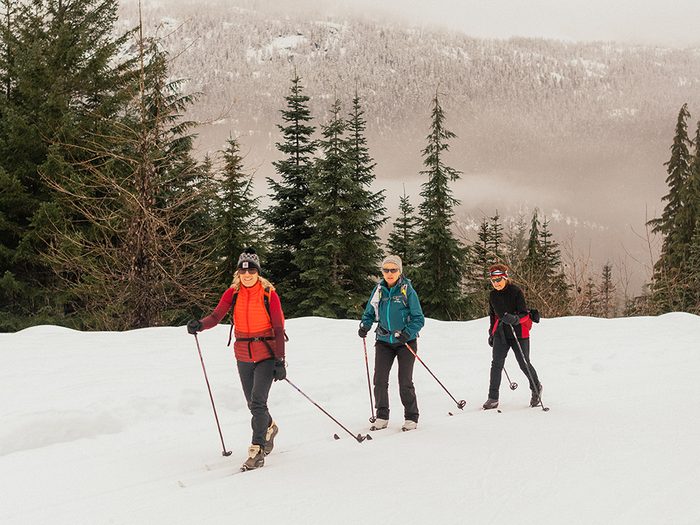
Nordic skiing (a.k.a. cross-country skiing) is not only a great workout—it’s also accessible, social and easy to learn, no matter your age.
I’ve loved the steep, powdery pitches of downhill skiing for years. But some time before I turned 50, my body started to rebel against the high-impact jostling of black-diamond runs (sore knees, sore hips, a back that kept going out).
So, last winter, my husband and I did what I had once seen as unthinkable: We invested in cross-country gear and ended up spending twice as many days gliding zen-like through the forest than we did chasing fresh tracks at an alpine resort.
At first we poked fun at our newfound Nordic pastime—the fitted, streamlined clothes, the slow pace, the awkwardness of toe-only bindings and the ridiculous downhill snow-plow stance (courtesy of those wildly untethered heels) that made us teeter precariously between staying upright and face-planting on the hard-packed corduroy. But something happened after those first few forays onto winding trails that were gloriously free of other people: We fell in love with the sport.
Being out in nature under a cobalt sky gives us a mental lift during the shortest days of the year, and that’s in addition to the mood boost we get from all that exercise. We don’t have to drive as far from our Kelowna, B.C. home to get to the trails, either, and Nordic doesn’t cost as much as its alpine counterpart.
As it turns out, we aren’t the only ones going all in for downhill skiing’s slower, flatter cousin. Mike Edwards, a manager at West Kelowna skiing club Telemark Nordic, says he noticed a 50-percent bump in membership over the first year of the pandemic, and a nearly 25-percent increase during the second year. It was hard to get our hands on skis, boots and poles last season, too: a perfect storm of supply chain issues meets increased demand.
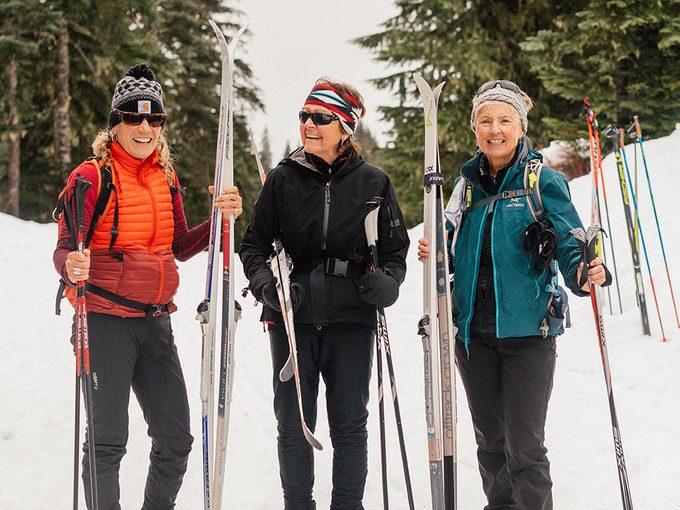
For many, COVID winters and lockdown gym closures supplied the push they needed to try Nordic skiing. Then, the sport’s many perks won plenty of people over permanently.
Lisa Monforton, a self-described “cross-country ski dabbler,” has grown a lot more serious about the sport over the last few years. She initially took a lesson with a girlfriend, and then started going out regularly to ski in Fish Creek Provincial Park near her home in Calgary.
“During the pandemic I just looked for new things to do in my life, whether it was weaving or baking or learning a new skill,” explains Monforton, who is 61. “And more of my friends are cross-country skiing.” She loves that it’s an aerobic, full-body exercise. It’s easier on her joints, too—particularly a problem knee. “Cross-country skiing doesn’t bother it at all,” she says.
It’s a similar story for Angela Sayers, who broke her patella in April 2020. Her physiotherapist forbade her from hitting the downhill slopes, but gave her the green light for Nordic skiing the following winter. Now, due to the financial and social advantages, Sayers says she doesn’t think she’ll go back.
“What I like about Nordic versus downhill is it’s not this big investment of time and money. It’s free,” says the Calgarian, who just turned 50. “It’s so accessible, it’s so easy. You can take an hour, go skiing and be home, instead of driving all the way to the mountains.”
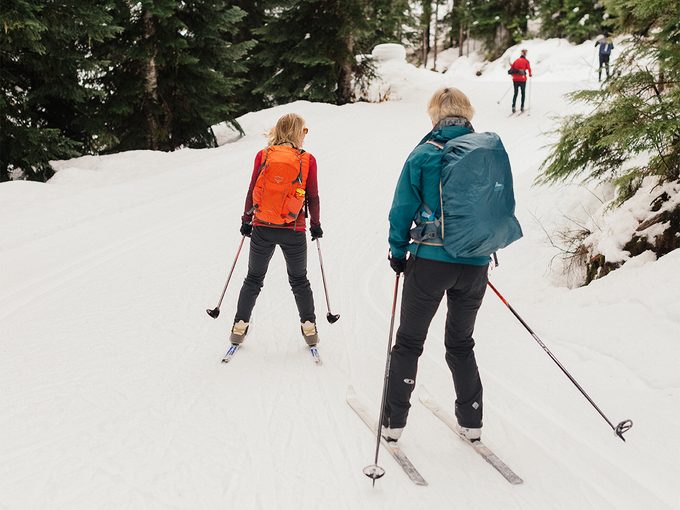
Last winter she met a friend every Friday morning to catch up and ski either at the one-kilometre Nordic loop in Calgary’s East Village, located downtown, or at a local city golf course with track-set trails (that’s where a grooming machine makes two parallel grooves in the snow for skiers to glide along).
“It’s a good winter alternative to the walk,” Sayers says, adding that she and her friend would sometimes bring a Thermos and turn the outing into a tailgate party—the Nordic version of après ski.
It’s also a sport you can do at any age. Jenna Sim, a cross-country ski coach at Telemark Nordic, loves that she sees everyone from four-year-old girls to 85-year-old women out on the trails. Part of its appeal for the very young—and for the aging and elderly—is that it’s a relatively safe, low-risk activity.
“A lot of times people are nervous about winter sports because they don’t want to fall and get hurt,” explains Sim, who coaches kids ages 11 to 14. “Nordic skiing is great because of the low-impact nature and the speed that you’re going. People feel like they can be in more control because they’re not going as fast, so the risk doesn’t feel as high-consequence.” I fell plenty last winter as a newbie, and I am pleased to report that my knees, hips and lower back have weathered these stumbles just fine.
When Nordic skiers do experience sprains or breaks, they’re usually caused by a fall, says Ross McKinnon, a Kelowna-based physiotherapist who regularly treats sports injuries. Unlike with high-speed alpine crashes, tumbles from Nordic skiing are usually from losing balance on a gentle downhill grade or while going around a corner, or from catching an edge while stepping into or out of tracks.
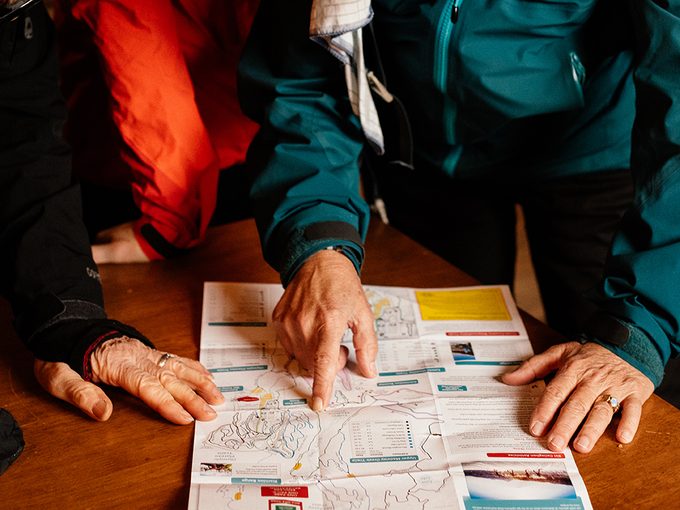
McKinnon notes that he typically treats far more injuries from downhill skiing and snowboarding than from Nordic. “Cross-country skiing is one of the safest winter sports out there,” he says.
As my technique improves, I’m sure I’ll master the proper way to stop rather than simply—ahem—“sitting down” on intermediate runs.
I’m also hoping the sport’s amazing health benefits will transform me into a super-fit 50-something. After all, Nordic skiing really is the perfect winter workout, and that’s not just my bias speaking. Experts confirm it: Cross-country burns a ton of calories, uses your leg, arm and core muscles and provides that mental health boost so many of us need this time of year.
“Nordic skiing can be one of the most intense, demanding activities you can do,” says John Holash, a professor of health and human performance in the Faculty of Kinesiology at the University of Calgary. “You’re using the muscles of your upper back, your triceps, your shoulders, your deltoids. You have to stabilize with all your core muscles. And then, in addition to that, you’re using all of your hip flexors and lower legs.”
What’s more, some of the people with the highest reported cardiovascular fitness are cross-country skiers, says Holash.
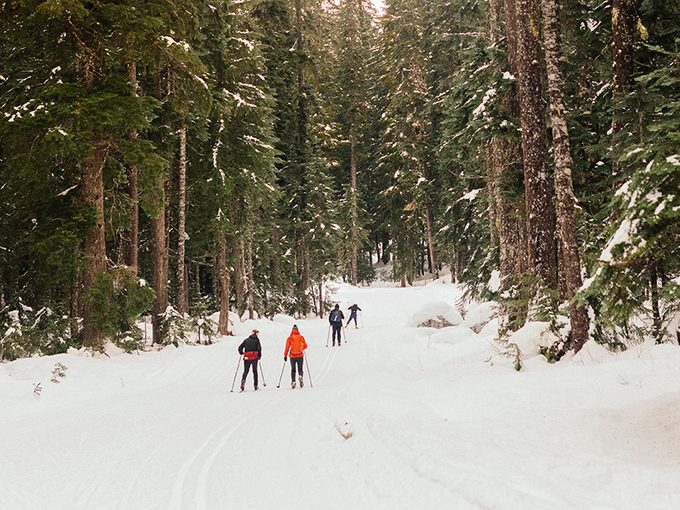
A few years ago, doctors in Canada began prescribing time in nature to help patients manage anxiety and improve their physical and mental health. I’ve certainly found this to be effective, and I plan to keep prescribing myself a weekly cross-country ski excursion as a winter survival strategy for many years to come. Here are some of the other health benefits:
Calories Burned
A 2016 study published in the Journal of Sports Science & Medicine found that Nordic skiing burns more calories in one hour than downhill skiing does in 2.5 hours. “It’s a continuous activity,” explains Holash. “When you’re cross-country skiing, you’re not taking a break while you sit on a chair and go back up the mountain. And the exercise tends to be more of a moderate to heavy intensity.”
Bone Density
Nordic skiing is easier on the joints than running, and it maintains bone density. “With cross-country-skiing, you don’t really have that heel-strike impact like you do with running,” says McKinnon. “You’re weight-bearing, you’re sliding back and forth, so it’s lower impact that way. But it’s also the pull of the muscles on your bones that helps keep them strong.”
Maintaining bone density and muscle mass is especially important for women as they age. “After menopause, our bone density can decrease, and cross-country skiing is a great weight-bearing activity while also being low impact,” says Sim.
Balance and Flexibility
Nordic skiing is great for balance and agility as you age. It keeps you on your toes, literally. “Outside in a natural environment, you’re constantly being exposed to balance issues,” says Holash, noting that the terrain alternates between slick and slushy, steep and flat, or there might be pinecones or debris to avoid on the tracks. “Cross-country skiing also works the flexibility of our body because it goes through a very large range of motion. It’s an activity that promotes flexibility.”
Cold-Weather Endorphins
Many people feel cheerful when they exercise outside in winter, and science can explain why: Being cold during exercise might actually make us happier by stimulating our sympathetic nervous system, which then releases more endorphins. “You go into a cold environment, you’ll get an adrenalin rush,” says Holash.
Anxiety Management
What’s more, the goal-oriented, horizontal eye-scanning movement that accompanies outdoor sports has been shown to reduce activity in the amygdala, which is the brain’s fear centre, says Holash. The motor planning you do outdoors is far more complex than when you’re zoning out on a treadmill or spin bike. “Almost all of your senses are being pushed to a 10, whether it’s visual, auditory, sensation, balance, smell. The brain is getting a massive amount of input that it has to coordinate,” he explains. Simply getting yourself moving outside, with purpose, can help manage feelings of stress and anxiety.




